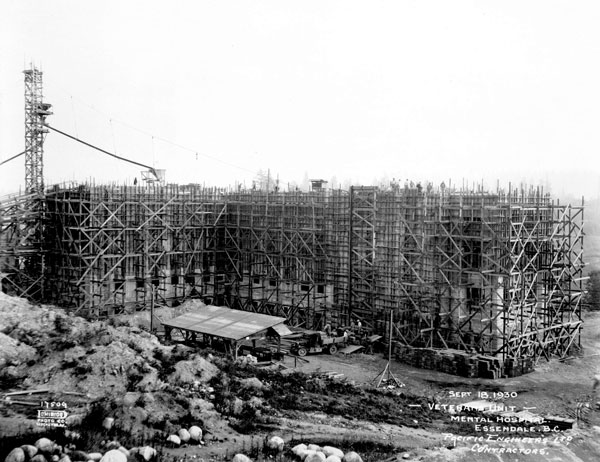The latest chapter in the long history of səmiq̓wəʔelə, an iconic site in Coquitlam, B.C., came earlier this year. BC Housing and kʷikʷəƛ̓əm (Kwikwetlem First Nation) announced it would no longer be called Riverview Lands and plans were underway to redevelop the 244-acre property.
But the decades leading up to the change have had many twists and turns. Here are four facts you maybe didn’t know about səmiq̓wəʔelə.
Spiritual design
Some of the first structures on the property were designed by John Charles Malcolm Keith in the early 20th century. Keith was well known on Vancouver Island as a church architect, particularly for Anglican church buildings. Keith was tasked with constructing the Hospital for the Mind in 1908 after winning a provincewide competition.
The scope of the project included an administration building, an acute care building, a sick and infirm building, an epilepsy building, a pair of chronic buildings and housing for nurses.
According to a heritage inventory published by the University of British Columbia, the original design called for buildings to be laid out in the “corridor-pavilion style,” with a central administration building having twin domed towers that reflect the symmetrical division of the site into male and female halves arranged around a surrounding horseshoe.
Heritage researchers say Keith’s involvement in the project did not continue into construction for unknown reasons. Researchers noted one of the first buildings in the plan represents one of the first large-scale examples of an emerging technology: reinforced concrete.

Room to grow
The property was also home to Canada’s first true botanical garden. According to the Canadian Register of Historic Places, the garden was championed by B.C.’s first provincial botanist, John Davidson, and Bence Stinchcombe, who oversaw the grounds.
In 1917, the pair co-ordinated the transfer of 25,000 trees and shrubs were transferred to the newly-established UBC Botanical Gardens, allowing for the gardens to be integrated into the landscape of the property and hospital facilities. The site is still home to exotic trees as well as some of the oldest and largest in the Lower Mainland.
In 1951, staff member Art Finnie, an occupational therapist, and patients built a pioneer horticultural therapy garden later known as “Finnie’s Garden,” which is still maintained to this day. The site was also used as a nursery that supplied trees for public work projects throughout the province; some rows of nursery trees are still visible on the site.
Depression delays
According to documents from the City of Coquitlam, the province made plans to treat shell-shock victims coming back from the First World War. However, work on the Veteran’s Block was postponed in 1929 when the Great Depression rocked the economy. Work was completed in 1934. In the 1930s it cost less than a dollar a day to get treatment.
Significant expansions were made to the Veteran’s Block in the 1940s and it was renamed the Crease Clinic where a wider range of ailments were treated. It is one of the most famous structures on the property. It has been used in dozens of movies and TV shows including The X-Files, The Flash, Deadpool, Arrow, The 100 and more.

Millenniums of activity
According to kʷikʷəƛ̓əm, the land’s past goes back much further than when mental health facilities were first built.
Prior to 1904, the lands were part of kʷikʷəƛ̓əm’s core and ancestral territory. The First Nation noted that carbon-dated artifacts found on the site suggest kʷikʷəƛ̓əm activity going back 4,000 years. They are currently working with Brown and Oakes Archaeology to research and preserve the site’s pre-colonial history.
The site’s new name, səmiq̓ʷəʔelə (The Place of the Great Blue Heron), was decided on by BC Housing and kʷikʷəƛ̓əm as an act of reconciliation, that the land should formally be given a traditional name. It originated from kʷikʷəƛ̓əm membership, who have memories and accounts of the area being a nesting ground for herons.
Follow the author on Twitter @RussellReports.











Recent Comments